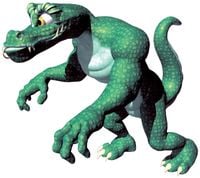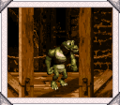Kobble
| Kobble | |||
|---|---|---|---|
 Artwork of a Kobble from Donkey Kong Country 3: Dixie Kong's Double Trouble! | |||
| First appearance | Donkey Kong Country 3: Dixie Kong's Double Trouble! (1996) | ||
| Latest appearance | Donkey Kong Country 3 (GBA) (2005) | ||
| Variant of | Kremling | ||
| Subject origin | Kritter | ||
| |||
| |||
Kobbles are basic, green Kremlings who serve as the grunts of the Kremling Krew in Donkey Kong Country 3: Dixie Kong's Double Trouble! and Donkey Kong Land III. They are the successor to Kritters and Klomps from Donkey Kong Country and Donkey Kong Country 2: Diddy's Kong Quest respectively.
Kobbles have a light green underbelly and a lip piercing. They have a purple counterpart that appears in some snow levels, Skiddas.
History
Donkey Kong Country 3: Dixie Kong's Double Trouble!
In Donkey Kong Country 3: Dixie Kong's Double Trouble!, despite being one of the weakest enemies, Kobbles only appear in three boardwalk levels, Lakeside Limbo, Tidal Trouble, and Kreeping Klasps. Like most enemies, Kobbles walk back and forth in a pattern, and Dixie Kong and Kiddy Kong can defeat them by using any attack.
In Dixie Kong's Photo Album, a photograph of Kobble is categorized under the "Kremling Kreeps" enemy class. The photograph shows a Kobble in a mill area even though they do not appear in any mill levels.
In the Game Boy Advance remake, Kobbles make a higher-pitched voice when defeated, which Kritters and Klomps also make when defeated in the respective two previous Game Boy Advance remakes. The only Kobble of Tidal Trouble does not appear in the Game Boy Advance remake, reducing their presence even more than in the original.
Donkey Kong Land III
In Donkey Kong Land III, Kobbles act the same as in the previous game. Kobbles appear in many more levels, a total of 18, and in more settings than boardwalks:
- Red Wharf
- Ford Knocks
- Total Rekoil
- Liftshaft Lottery
- Jetty Jitters
- Riverbank Riot
- Rocketeer Rally
- Vertigo Verge
- Jungle Jeopardy
- Footloose Falls
- Karbine Kaos
- Rockface Chase
- Clifftop Critters
- Bazuka Bombard
- Ugly Ducting
- Kuchuka Karnage
- Barrel Boulevard
- Ghoulish Grotto
Gallery
Donkey Kong Land III sprite
Names in other languages
| Language | Name | Meaning | Notes |
|---|---|---|---|
| Japanese | コブル[?] Koburu |
Kobble | |
| Italian | Kobble[?] | - |
| Kremlings | |
|---|---|
| Characters | Congazuma • Cranky K. Rool • Draglinger • General Klump • Giant Viking Kremling • Green Kroc • Jr. Klap Trap • Junklomp • K. Lumsy • Kalypso • Kaptain Skurvy • Kass • Kerozene • King K. Rool • King Kut Out • Kip • Klubba • Kleever • Kludge • Krunch • Krunch's mother • Krusha • Krushy • Kudgel • Kutlass • Mega Amp • Okusan • Quint Skurvy • Resident demon |
| Species | Bazuka • Ghost • Kaboing • Kaboom • Kackle • Kannon • Kasplat • Klampon • Klank • Klaptrap • Klasp • Klinger • Kloak • Klobber • Klomp • Klump • Knocka • Kobble • Koin • Koindozer • Kopter • Kosha • Kracka • Krash • Kremling boater • Kremling cop • Krimp • Kritter • Kroc • Krockhead • Krook • Krumple • Kruncha • Krusha • Kuchuka • Kuff 'n' Klout • Kutlass • Re-Koil • Robokremling • Rock Kroc • Shroom • Skeleton Kremling • Skidda • Super Team goalie |

